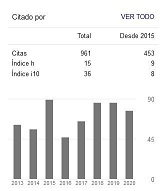Resources, Reproductive Performance, and Animal Management on Equine Breeding Farms in Azuay, Ecuador
Resumen
Background: The general operations of horse breeding systems are seldom studied. The aim of this paper was to carry out a thorough characterization of horse farms in the province of Azuay, Ecuador.
Methods: Out of the 63 breeding farms authorized by the state agency of Azuay with more than five animals, and operational for over two years, 45 were chosen for sample collection. The information considered variables area, pasture, animals, zootechniques, reproduction, health, and expenses. The analysis showed the basic statigraphs, principal components with Varimax rotation and k-mean cluster analysis, and the statistics for each cluster.
Results: The first component explained more than a third of total variation, and related the determining variables of infrastructure, total area, pasture, and area for facilities. The second component is co-related to the number of parturitions and estrus repetition. The third component is co-related to management and greater animal wellbeing. Two clusters with differences in terms of area, number of animals, availability of resources, and reproductive performance, were found.
Conclusions: Today, the main factors to tackle horse system improvements in the province of Azuay are grassland improvements, animal management, and reproductive performance.
Descargas
Citas
Agrocalidad. (2016). Agencia de regulación y control fito y zoosanitario. Retrieved on April 27, 2019, from http://www.agrocalidad.gob.ec
Catelli, J. L., Caviglia, J. F., Tassara, M. L. y Giménez, R. (2006). Producción de equinos para carne. Revista de Ciencias Agrarias y Tecnología de los Alimentos, 24 (1), 1-12.
Claes, A., Ball, B. A., Scoggin, K. E., Roser, J. F., Woodward, E. M., Davolli, G. M., Squires, E. L. y Troedsson, M. H. (2017). The influence of age, antral follicle count and diestrous ovulations on estrous cycle characteristics of mares. Theriogenology, 97 (2), 34-40.
Córdova A.I., Villa, E.A.M., Huerta, R.C. y Rodríguez, B.E.D. (2017). Factores externos que pueden ocasionar estrés en caballos. Revista Complutense de Ciencias Veterinarias, 11(1), 43-68.
Ishii, M., Shimamura, T., Utsumi, A., Jitsukawa, T., Endo, M., Fukuda, T. y Yamanoi, T. (2001). Reproductive per-formance and factors that decrease pregnancy rate in heavy draft horses bred at the foal heat. Journal of Eq-uine Veterinary Science, 21(3), 131-136.
Morley, S. A. y Murray, J. A. (2014). Effects of body condition score on the reproductive physiology of the brood-mare: a review. Journal of Equine Veterinary Science, 34(7), 842-853.
National Geospatial-Intelligence Agency. (2017). Bethesda, MD, USA. Retrieved on April 27, 2019, from https://geografiainfo.es/nombres_geograficos/name.php?uni=-1368374&fid=1579&c=ecuador
Paredes, P., Jiménez, C. y Hernández, A. (2013). Diámetro del cuerpo lúteo y niveles de progesterona sérica, durante el ciclo estral en yeguas criollas colombianas. Revista MVZ Córdoba, 18(3), 3829-3835.
Park, J. E., Lee, J. R., Oh, S., Lee, J. W., Oh, H. S. y Kim, H. (2011). Principal components analysis applied to genetic evaluation of racing performance of Thoroughbred race horses in Korea. Livestock science, 135(2-3), 293-299.
Posta, J., Komlosi, I. y Mihok, S. (2007). Principal component analysis of performance test traits in Hungarian Sporthorse mares. Archives Animal Breeding, 50(2), 125-135.
Rodríguez Mejía, S., Flores Sánchez, D., León Merino, A., Pérez Hernández, L. M. y Aguilar Ávila, J. (2018). Diag-nóstico de sistemas de producción de bovinos para carne en Tejupilco, Estado de México. Revista mexicana de ciencias agrícolas, 9(2), 465-471.
Toro-Mujica, P., García, A., Gómez-Castro, A. G., Acero, R., Perea, J., Rodríguez-Estévez, V., Aguilar, C. y Vera, R. (2011). Technical efficiency and viability of organic dairy sheep farming systems in a traditional area for sheep production in Spain. Small Ruminant Research, 100(2-3), 89-95.
Wespi, B., Sieme, H., Wedekind, C., & Burger, D. (2014). Exposure to stallion accelerates the onset of mares' cyclici-ty. Theriogenology, 82(2), 189-194.
Los autores de los artículos publicados en RPA retienen los derechos de autor de su trabajo, de marca y patente, y también sobre cualquier proceso o procedimiento descrito en el artículo, así como a compartir, copiar, distribuir, ejecutar y comunicar públicamente el artículo publicado en la RPA o cualquier parte de aquel siempre que indiquen la fuente de publicación (autores del trabajo, revista, volumen, número y fecha), pero están de acuerdo en que la revista publique los trabajos bajo una licencia Creative Commons.
![]() Licencia Attribution-NonCommercial 4.0 International (CC BY-NC 4.0)
Licencia Attribution-NonCommercial 4.0 International (CC BY-NC 4.0)






































